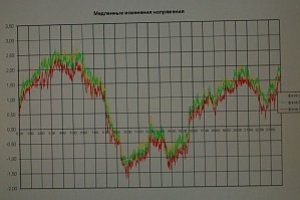

Starting from July 1, 2014 in connection with the entry into force of GOST 32144-2013 "Electricity. Compatibility of technical equipment. Quality standards of electrical energy in power systems of general purpose" power engineers of IDGC of Centre - Lipetskenergo division shifted to new standards in the measurement and analysis of electric power quality, being fully compatible with international ones.
Introduction of new rules is a long overdue necessity conditioned with modern requirements of market relations in the electric power industry and economy of the country, according to which electricity is a commodity that has a certain quality, and is a strategic resource, requiring efficient and careful use. That is why the analysis and control of electric power quality today has an important place.
And the new GOST, increasing requirements to accuracy for measuring and assessing the quality of electricity, as well as establishing the new boundaries of their definition, is clear evidence of this. According to it on 1 July this year the electric power quality measurement is made at the point where electricity is delivered to consumers - at the boundary point and not on the lead terminals of electricity, installations as it was before. This means that up to the boundary a grid company is responsible for the quality of electricity, and after it - it is already the consumer. In other words, not only an electricity supplier must maintain frequency and voltage of electric current at the connection point of the consumer, but the consumer as well as the work of his power installations affects the quality of electricity.
For example, if you find that consumers use appliances with non-linear load or perform unauthorized welding, then the entire responsibility for the voltage drops in the grid will be placed on him.
Only specialists can identify reasons for the emergence of "bad energy" in the grids, as most of the processes occurring in electrical networks are fast flowing, all regulated quality of electrical energy cannot be measured directly — they must be calculated, and the final conclusion can only be given by results of statistically processed measurement values. For this reason, electric power quality control is performed using special instruments and equipment with type approval and certificate of verification. In accordance with the requirements the power quality analysis is carried out by qualified personnel who have been trained and who have passed the necessary examinations. Only those experts are allowed to do this work who in the process of training and education received permission to perform such measurements.
"Often consumers check their own electricity supply with the help of various electrical equipment, showing some instantaneous value. Seeing figures different from 220 V, they begin to believe that they are served with poor quality of electricity. Calm down - it's not so! The fact is that 220 V is nominal voltage, regulated by GOST 21128, but the indicator of quality, as slow changes in voltage, which is in the old GOST 13109-97 are called steady voltage deviation can vary 10% in the range of the nominal voltage or balanced. That is electricity supply can range from 198 to 242 V and thus will meet the established by GOST 32144-2013 values without affecting work of electrical appliances," commented Electricity Quality Engineer of Department of Metrology and Quality of Electricity of Lipetskenergo Tatiana Levashko.